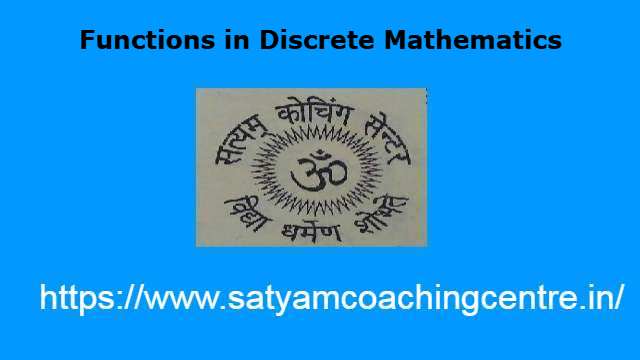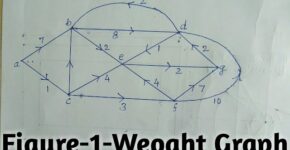Functions in Discrete Mathematics
1.विविक्त गणित में फलन (Functions in Discrete Mathematics),फलन (Functions):
विविक्त गणित में फलन (Functions in Discrete Mathematics) के इस आर्टिकल में फलनों के कुछ प्रकार,फलनों पर आधारित प्रमेयों के बारे में अध्ययन करके समझने का प्रयास करेंगे।
आपको यह जानकारी रोचक व ज्ञानवर्धक लगे तो अपने मित्रों के साथ इस गणित के आर्टिकल को शेयर करें।यदि आप इस वेबसाइट पर पहली बार आए हैं तो वेबसाइट को फॉलो करें और ईमेल सब्सक्रिप्शन को भी फॉलो करें।जिससे नए आर्टिकल का नोटिफिकेशन आपको मिल सके।यदि आर्टिकल पसन्द आए तो अपने मित्रों के साथ शेयर और लाईक करें जिससे वे भी लाभ उठाए।आपकी कोई समस्या हो या कोई सुझाव देना चाहते हैं तो कमेंट करके बताएं।इस आर्टिकल को पूरा पढ़ें।
Also Read This Article:- Lattices in Discrete Mathematics
2.विविक्त गणित में फलन पर आधारित प्रमेय (Theorems Based on Functions in Discrete Mathematics):
(1.)उपसमुच्चय का प्रतिलोम प्रतिबिम्ब (Inverse Image of a Subset):
माना f: X \rightarrow Y समुच्चय X से समुच्चय Y में कोई फलन है तथा B \subseteq Y .तब उपसमुच्चय B का फलन f के अन्तर्गत प्रतिलोम प्रतिबिम्ब,समुच्चय X के उन सभी अवयवों का समुच्चय होता है,जिनका f-प्रतिबिम्ब उपसमुच्चय B में विद्यमान है।इसे हम f^{-1}(B) द्वारा व्यक्त करते हैंः
अतः f^{-1}(B)=\{x \in X: f(x) \in B\} \subseteq X
प्रमेय (Theorem):1.माना X तथा Y अरिक्त समुच्चय हैं तथा f: X \rightarrow Y एक फलन हैं।यदि A \subseteq X तथा B \subseteq Y ,तब
(Let X and Y be non-empty sets and f a function from the set X to set Y i.e. f: X \rightarrow Y , If A \subseteq X and B \subseteq Y then):
(i) A \subseteq f^{-1}[f(A)] ,व्यापक रूप से (in general) A \neq f^{-1}[f(A)]
(ii) f\left[f^{-1}(B)\right] \subseteq B ,व्यापक रूप से (in general) f\left[f^{-1}(B)\right] \neq B
उपपत्ति (Proof):(i).माना x \in A ,तब
x \in A \Rightarrow f(x) \in f(A) \\ \Rightarrow x \in f^{-1} [f(A)] \\ \therefore A \subseteq f^{-1}[f(A)]
व्यापक रूप से हम निम्न उदाहरण द्वारा प्रदर्शित करते हैं कि A \neq f^{-1}[f(A)]
माना f: R \rightarrow R ; f(x)=x^2, \forall x \in R
यहाँ R,वास्तविक संख्याओं का समुच्चय है।
तथा A=\{x \in R:-1 \leq x \leq 0\} \subseteq R (प्रान्त)
तब f(A)=\{x \in R \therefore 0 \leq x \leq 1\} \subseteq R (सहप्रान्त)
तथा f^{-1}\{f(A)\}=\{x \in R \mid-1 \leq x \leq 1\} \neq A
अतः A \neq f^{-1}[f(A)]
(ii)माना y \in f \left[f^{-1}(B)\right] ,तब
y \in f\left[f^{-1}(B)\right] \Rightarrow y=f(x) जहाँ x \in f^{-1}(B) \\ \Rightarrow y=f(x) जहाँ f(x) \in B \\ \Rightarrow y \in B \\ \therefore f\left[f^{-1}(B)\right] \subseteq B
व्यापक रूप से हम निम्न उदाहरण द्वारा प्रदर्शित करते हैं कि f\left[f^{-1}(B)\right] \neq B
माना f=R \rightarrow R ; f(x)=x^2, \forall x \in R
तथा B=[-1,0] \subset R (सहप्रान्त)
तब f^{-1}(B)=\{0\} \subset R (प्रान्त)
तथा f\left[f^{-1}(B)\right]=\{0\} \neq [-1,0]=B
अतः f\left[f^{-1}(B)\right] \neq B
टिप्पणी (Remark):1.यहाँ पर ध्यान देने योग्य बात यह है कि यदि A \subseteq X ,तब
f(x) \in f(A) \notin x \in A (व्यापक रूप से)
(2.)निम्नतमांक तथा उच्चतमांक फलनों के गुण (Properties of the Floor and Ceiling Functions):
यदि x एक वास्तविक संख्या तथा m एक पूर्णांक है,तो
(i) \left\lfloor x \right\rfloor=m , यदि और केवल यदि m \leq x < m+1
(ii) \left\lfloor x \right\rfloor=m , यदि और केवल यदि x-1 < m \leq x
(iii) \left\lceil x \right\rceil=m, यदि और केवल यदि m-1 < x \leq m
(iv) \left\lceil x \right\rceil=m, यदि और केवल यदि x \leq m < x+1
(v) x-1 < \left\lfloor x \right\rfloor \leq x \leq \left\lceil x \right\rceil < x+1
(vi) \left\lfloor -x \right\rfloor =- \left\lceil x \right\rceil
(vii) \left\lceil -x \right\rceil =- \left\lfloor x \right\rfloor
(viii) \left\lceil x+m \right\rceil =\left\lfloor x \right\rfloor +m;
(ix) \left\lceil x+m \right\rceil=\left\lceil x \right\rceil +m
(3.)फलन का संकुचन (Restriction of a Function):
माना X तथा Y दो समुच्चय हैं तथा f: X \rightarrow Y समुच्चय X से Y में एक फलन है।माना A \subseteq X ;तब फलन
g: A \rightarrow Y s.t g(x)=f(x) \forall x \in A फलन f का समुच्चय A पर संकुचन (restriction of f to A) कहलाता है।इसे f/A से व्यक्त करते हैं।फलन f को फलन g का विस्तार (extension) कहते हैं।
(4.)हैश फलन (Hash Function):
कम्प्यूटर पर सूचनाओं के संदर्भ में “फाईल” (file),रिकार्ड (record),फील्ड (field) इत्यादि नामों का बहुधा प्रयोग होता है।उदाहरण के लिए,फाइल,कम्पाइलर (complier) या असेंबलर (assembler) की एक प्रतीक सारणी है,जिसमें सम्बन्धित मानों के साथ लेबल (labels) तथा वर्ग (literals) इत्यादि चर राशियाँ होती हैं।प्रतीक सारणी की प्रत्येक प्रविष्टि (entry) को “रिकार्ड” कहते हैं।रिकार्ड सदैव फीते (tape) पर संचयित रहते हैं तथा (skip forward),(skip backward) या रीवाइण्ड (rewind) जैसी संक्रियाओं द्वारा इनका आंकलन होता है।प्रत्येक रिकार्ड का एक फील्ड (field) होता है,जिनकी अभिकल्पना रिकार्ड की कुंजी (key) के रूप में की जाती है।यह कुंजी को पहचान कर बताती है कि रिकार्ड किस स्थान पर संचयित है?प्रत्येक कुंजी द्विचर प्रकृति की होती है जिसे द्विचर संख्या (binary number) के रूप में व्यक्त किया जाता है।
माना कि कुंजी का संख्यात्मक मान “k” है।हैश फलन (Hash function) h(k) प्रत्येक रिकाॅर्ड को एक अद्वितीय स्मृति अवस्थिति (memory location) से सम्बद्ध करता है।यदि प्राप्य (available) स्मृति अवस्थितियों की संख्या m है तब हैश फलन को निम्न प्रकार से परिभाषित किया जाता है:
h(k)=k (mod m)
अर्थात् h(k) वह शेषपद (remainder) है जो k को m से विभाजित करने पर प्राप्त होता है।
अतएव h(k),समुच्चय {0,1,2,……,m-1} का अवयव है।संक्षेप में,हैश फलन,कुंजियों के समुच्चय (set of keys) को m अवस्थितियों (locations) के समुच्चय में प्रतिचित्रित करता है तथा तब इसका संख्यात्मक मान समुच्चय {0,1,2,…….,m-1} का कोई अवयव है।
उदाहरण के लिए,माना m=113,तब यदि किसी विद्यार्थी का सुरक्षा नामांक (security number) 059218592 है तो इस विद्यार्थी का रिकाॅर्ड स्मृति अवस्थिति 38 में रखा जायेगा,चूँकि
h (059218592)=059218592 (mod 113)=38
इसी प्रकार सुरक्षा नामांक 035921854 वाले विद्यार्थी का रिकॉर्ड स्मृति अवस्थिति 58 में दर्ज किया जायेगा चूँकि h(035921854)=035921854 (mod 113)=58
(5.)अभिलक्षण फलन (Characteristic Function):
माना U सार्वत्रिक समुच्चय (Universal Set) तथा A,U का उपसमुच्चय है।तब फलन
\psi_A=\cup \rightarrow\{0,1\} जहाँ \psi_A(x)=\left\{\begin{array}{l} 1 ; \text { यदि } x \in A \\ 0 ; \text { यदि } x \notin A \end{array}\right.
समुच्चय A का अभिलक्षण फलन (Characteristic Function) कहलाता है।
अभिलक्षण फलन की सहायता से समुच्चयों से सम्बन्धित कथनों तथा उनकी संक्रियाओं को कम्प्यूटर पर,द्विचर संख्याओं (binary numbers) 0 तथा 1 के रूप में व्यक्त किया जा सकता है जिससे उनका परिचालन (manipulation) अत्यधिक आसान हो जाता है।
माना X={a,b,c} ;तब \phi ,{a},{b},{c},{a,b},{a,c},{b,c} और {a,b,c} सभी समुच्चय X के उपसमुच्चय हैं।निम्नलिखित सारणी में उन सभी उपसमुच्चयों के अभिलक्षण फलनों के मान दिये गये हैं:
\begin{array}{|c|c|c|c|c|c|c|c|c|} \hline A & \phi & \{a\} & \{b\} & \{c\} & \{a, b\} & \{a, c\} & \{b, c\} & \{a,b,c\} \\ \hline a & 0 & 1 & 0 & 0 & 1 & 1 & 0 & 1 \\ b & 0 & 0 & 1 & 0 & 1 & 0 & 1 & 1 \\ c & 0 & 0 & 0 & 1 & 0 & 1 & 1 & 1 \\ \hline \end{array}
उपर्युक्त सारणी से यह स्पष्ट है कि समुच्चय X के उपसमुच्चयों के अभिलक्षण फलनों के मानों में तीन द्विचर अंक विद्यमान हैं।
माना B={000,001,010,011,100,101,110,111}
तब उपर्युक्त सारणी समुच्चय X के घात समुच्चय P(X) से समुच्चय B में एक फलन है।यह सम्बन्ध एकैकी (one-one) तथा आच्छादक (onto) है।अतः समुच्चयों P(X) तथा B के मध्य एकैकी संगति (one to one correspondence) स्थापित करता है।
प्रमेय (Theorem):2.यदि A तथा B सार्वत्रिक समुच्चय U के उपसमुच्चय हैं तब सभी x \in \cup के लिए
(If A and B are the subsets of the universal set U,then for all x \in \cup ),
(i)\psi_A(x)=0 \Leftrightarrow A=\phi
(ii)\psi(x)=1 \Leftrightarrow A=U
(iii)\psi_A(x) \leq \psi_B(x) \Leftrightarrow A \subseteq B
(iv) \psi_A(x)=\psi_B(x) \Leftrightarrow A=B
(v) \psi_{A \cap B}(x)=\psi_A(x) \times \psi_B(x)
(vi) \psi_{A \cup B}(x)=\psi_A(x)+\psi_B(x)-\psi_A(x) \times \psi_B(x)
(vii) \psi_{A^{\prime}} (x)=1-\psi_A(x)
(viii) \psi_{A-B}(x)=\psi_A(x)-\psi_A(x) \times \psi_B(x)
जहाँ संक्रियाएँ \leq, +, × और – सामान्य अंकगणित संक्रियाएँ हैं (क्योंकि विलक्षणता फंक्शन का मान या तो 1 या 0 होता है।)
where operations \leq ,+, × and – are usual arithmetic operations (as the value of the characteristic function is either 1 or 0.)
उपपत्ति (Proof): (i) \psi_A(x)=0 \Leftrightarrow x \notin A , \forall x \in U \Leftrightarrow A=\phi \\ \therefore \psi_A(x)=0 \Leftrightarrow A=\phi, \forall x \in U
(ii) \psi_A(x)=1 \Leftrightarrow x \in A, \forall x \in U \Leftrightarrow A=U \\ \therefore \psi_A(x)=1 \Leftrightarrow A=U
(iii)माना \psi_A(x) \leq \psi_B(x) तथा x \in A
तब x \in A \Rightarrow \psi_A(x)=1
परन्तु \psi_A(x) \leq \psi_B(x) \\ \therefore x \in A \Rightarrow \psi_B(x)=1 \quad \left[\because \psi_B(x)=1 \text{या} 0 \right] \\ \Rightarrow x \in B
अतः A \subseteq B
विलोमतःमाना कि A \subseteq B
तब x, x \in A \Rightarrow x \in B
अर्थात् \psi_A(x)=1 \Rightarrow \psi_B(x)=1 \\ \Rightarrow \psi_A(x) \leq \psi_B(x) \forall x \in A \cdots(1)
तथा यदि x \notin A तब x \notin A \Rightarrow x \in U-A \\ \Rightarrow x \in B या x \notin B \\ \therefore \psi_A(x)=0 \Rightarrow \psi_B(x)=1 या \psi_B(x)=0
अतः \psi_A(x) \leq \psi_B(x) \ldots(2)
(1) तथा (2) से, A \subseteq B \Rightarrow \psi_A(x) \leq \psi_B(x)
अतः \psi_A(x) \leq \psi_B(x) \Leftrightarrow A \subseteq B
(iv)माना \psi_A(x)=\psi_B(x) \forall x \in U ,तब निम्न दो सम्भावनाएँ हैं:
सर्वप्रथम माना कि \psi_A(x)=0=\psi_B(x) \\ \Rightarrow A=\phi तथा B=\phi \\ \Rightarrow A=B
अब माना कि \Psi_A(x)=1=\Psi_B(x) \Rightarrow A=U=B \\ \therefore A=B
अतः प्रत्येक स्थिति में
\psi_A(x)=\psi_B(x) \Rightarrow A=B
विलोमतःमाना कि A=B तब यदि x \in A तो x \in B \\ \therefore \psi_A(x)=1=\psi_B(x)
तथा यदि x \notin A तो x \notin B \\ \therefore \psi_A(x)=0=\psi_B(x) \\ \therefore A=B \Rightarrow \psi_A(x)=\psi_B(x) \forall x \in U
अतः \psi_A(x)=\psi_B(x) \Leftrightarrow A=B
(v)माना x \in A \cap B
तब x \in A \cap B \Leftrightarrow x \in A तथा x \in B \\ \Leftrightarrow \Psi_A(x)=1 तथा \Psi_B(x)=1 \\ \Leftrightarrow \psi_A(x) \times \psi_B(x)=|x|=1
पुनः x \in A \cap B \Rightarrow \psi_{A \cap B}(x)=1 \\ \therefore x \in A \cap B \Rightarrow \psi_{A \cap B}(x)=1=\psi_A(x) \times \psi_B(x) \cdots(1)
परन्तु यदि x \notin A \cap B, तो \psi_{A \cap B}(x)=0
पुनः x \notin A \cap B \Rightarrow x \notin A या x \notin B \\ \Rightarrow \psi_A(x)=0 या \psi_B(x)=0 \\ \Rightarrow \psi_A(x) \times \psi_B(x)=0 \\ \therefore x \notin A \cap B \Rightarrow \psi_{A \cap B} (x)=0=\psi_A(x) \times \psi_B(x) \cdots(2)
(1) तथा (2) से,
\psi_{A \cap B}(x)=\psi_A(x) \times \psi_B(x), \forall x \in U
(vi)माना x \in A \cup B
तब x \in A \cup B \Rightarrow x \in A या x \in B या (x \in A और x \in B)
प्रथम स्थिति में,जब x \in A तथा x \notin B
तब \psi_A(x)=1 तथा \psi_B(x)=0
\therefore \psi_A(x) \times \psi_B(x)=\phi
अतः \psi_A(x)+\psi_B(x)-\psi_A(x) \times \psi_B(x)=1+0-0=1;
द्वितीय स्थिति में,जब x \notin A तथा x \in B
तब \psi_A(x)=0, \psi_B(x)=1 तथा \psi_A(x) \times \psi_B(x)=0
अतः \psi_A(x)+\psi_B(x)-\psi_A(x) \times \psi_B(x)=0+1-0=1 ;
तथा तृतीय स्थिति में,जब x \in A तथा x \in B
तब, \psi_A(x)=1 ; \psi_B(x)=1 तथा \psi_A(x) \times \psi_B(x)=1
अतः \psi_A(x)+\psi_B(x)-\psi_A(x) \times \psi_B(x)=1+1-1=1
अतएव प्रत्येक स्थिति में,
x \in A \cup B \Rightarrow \psi_A(x)+\psi_B(x)-\psi_A(x) \times \psi_B(x)=1
परन्तु x \in A \cup B \Rightarrow \psi_{A \cup B}(x)=1 \\ \therefore x \in A \cup B \Rightarrow \psi_{A \cup B}(x)=\psi_A(x)+\psi_B(x)-\psi_A(x) \times \psi_B(x) \cdots(1)
अब x \not \subset A \cup B \Rightarrow x \notin A तथा x \notin B \\ \Rightarrow \psi_A(x)=0 तथा \psi_B(x)=0 \\ \Rightarrow \psi_A(x) \times \psi_B(x)=0 \\ \therefore \psi_A(x)+\psi_B(x)-\psi_A(x) \times \psi_B(x)=0+0-0=0
पुनः x \notin A \cup B \Rightarrow \psi_{A \cup B}(x)=0 \\ \therefore x \notin A \cup B \Rightarrow \psi_{A \cup B}(x)=\psi_A(x)+\psi_B(x)-\psi_A(x) \times \psi_B(x) \cdots(2)
(1) तथा (2) से,
\psi_{A \cup B}(x)=\psi_A(x)+\psi_B(x)-\psi_A(x) \times \psi_B(x) ; \forall x \in U
(vii)सर्वप्रथम माना कि \psi_{A^{\prime}(x)}=1
तब \psi_{A^{\prime}(x)}=1 \Leftrightarrow x \in A^{\prime} \\ \Leftrightarrow x \notin A \\ \Leftrightarrow \psi_A(x)=0 \\ \Leftrightarrow 1-\psi_A(x)=1-0=1 \cdots(1) \\ \therefore \psi_{A^{\prime}}(x)=1 \Leftrightarrow 1-\psi_A(x)=0
अब माना कि \psi_{A^{\prime}(x)}=0
तब \psi_{A^{\prime}}(x)=0 \Leftrightarrow x \notin A^{\prime} \\ \Rightarrow x \in A \\ \Leftrightarrow \psi_A(x)=1 \\ \Leftrightarrow 1-\psi_A(x)=0 \\ \therefore \psi_A(x)=0 \Leftrightarrow 1-\psi_A(x)=0 \cdots(2)
(1) तथा (2) से,
\psi_{A^{\prime}}(x)=1-\psi_A(x) ; \forall x \in U
(viii)माना x \in A-B
तब x \in A-B \Rightarrow \psi_{A-B}(x)=1 \\ \therefore \psi_{A-B}(x)=1 \Rightarrow x \in A-B \\ \Leftrightarrow x \in A \text { तथा } x \notin B \\ \Leftrightarrow \psi_A(x)=1 तथा \psi_B(x)=0 \\ \Leftrightarrow \psi_A(x)-\psi_A(x) \times \psi_B(x)=1 \\ \therefore x \in A-B \Rightarrow \psi_{A-B}(x)=\psi_A(x)-\psi_A(x) \times \psi_B(x) \cdots(1)
अब माना कि x \notin A-B ; तब \psi_{A-B}(x)=0 \\ \therefore \psi_{A-B}(x)=0 \Leftrightarrow x \notin A-B \\ \Leftrightarrow x \notin A \cap B^{\prime} \\ \Leftrightarrow x \notin A या x \notin B^{\prime} \\ \Leftrightarrow \psi_A(x)=0 या \psi_B(x)=1 \\ \Leftrightarrow \psi_A(x)-\psi_A(x) \times \psi_B(x)=0 \\ \therefore x \notin A-B \Rightarrow \psi_{A-B}(x)=\psi_A(x)-\psi_A(x) \times \psi_B(x) \cdots(2)
(1) तथा (2) से,
\psi_{A-B}(x)=\psi_A(x)-\psi_A(x) \times \psi_B(x), \forall x \in U
(6.)एकैकी आच्छादक फलन (One-one onto function or one-to-one correspondence or Bijection):
फलन f: X \rightarrow Y एक एकैकी आच्छादक फलन कहलाता है यदि यह एकैकी तथा आच्छादक दोनों है।
प्रमेय (Theorem):3.यदि f: X \rightarrow Y एकैकी आच्छादक फलन है,तब f^{-1}: Y \rightarrow X भी एकैकी आच्छादक होता है।(अर्थात् एकैकी आच्छादक फलन का प्रतिलोम भी एकैकी आच्छादक होता है।)
(If f: X \rightarrow Y is a one-one onto function,then f^{-1}: Y \rightarrow X is also,one-one onto (i.e.,the inverse of a bijection function is also a bijection))
उपपत्ति (Proof):माना f: X \rightarrow Y जहाँ f(x)=y, \forall x \in X एकैकी आच्छादक फलन है।
तब f^{-1}: Y \rightarrow X जहाँ f^{-1}(y)=x \forall y \in Y , f का प्रतिलोम फलन है।
माना y_1, y_2 \in Y ,तब अवयव x_1, x_2 \in X इस प्रकार अवश्य होंगे कि
f^{-1}\left(y_1\right)=x_1 तथा f^{-1}\left(y_2\right)=x_2
अर्थात् f\left(x_1\right)=y_1 तथा f\left(x_2\right)=y_2 \cdots(1)
अब f^{-1}\left(y_1\right)=f^{-1}\left(y_2\right) \Rightarrow x_1=x_2 \\ \Rightarrow f\left(x_1\right)=f\left(x_2\right) [f की परिभाषा से]
\Rightarrow y_1=y_2 [(1) से]
\therefore f^{-1} एकैकी है।
पुनः माना कि x,समुच्चय X का कोई स्वेच्छ अवयव है;तब f की परिभाषा से अद्वितीय अवयव y \in Y इस प्रकार विद्यमान है कि
f(x)=y
या x=f^{-1}(y)
अर्थात् प्रत्येक x \in X के लिए एक अवयव y \in Y इस प्रकार है कि f^{-1}(y)=x
\therefore f^{-1} आच्छादक है।
अतएव f^{-1} एकैकी आच्छादक है।
प्रमेय (Theorem):4.यदि f: X \rightarrow Y एक एकैकी आच्छादक फलन f^{-1}: Y \rightarrow X है,तो प्रतिलोम फलन अद्वितीय होता है।
(If f: X \rightarrow Y is a one-one onto function f^{-1}: Y \rightarrow X ,then the inverse function is unique.)
उपपत्ति (Proof):माना f: X \rightarrow Y एक एकैकी आच्छादक फलन है।यदि सम्भव हो तो माना कि g : Y \rightarrow X तथा h: Y \rightarrow X के कोई दो भिन्न-भिन्न प्रतिलोम फलन हैं।तब प्रत्येक y \in Y के लिए,एक अवयव x_1 \in X इस प्रकार है कि
g(y)=x_1 तथा एक अवयव x_2 \in X इस प्रकार है कि h(y)=x_2
अब g(y)=x तथा h(y)=x_2 \\ \Rightarrow f\left(x_1\right)=y तथा f\left(x_2\right)=y \\ \Rightarrow f\left(x_1\right)=f\left(x_2\right) \\ \Rightarrow x_1=x_2 [ \because f एकैकी है]
\Rightarrow g(y)=h(y)
अतः g(y)=h(y) \forall y \in Y \Rightarrow g=h
अर्थात् f का प्रतिलोम फलन अद्वितीय है।
प्रमेय (Theorem):5.यदि f: X \rightarrow Y ,g : Y \rightarrow X तथा h : Z \rightarrow T फलन इस प्रकार हैं कि (hog)of तथा ho(gof) परिभाषित हैं,तब (hog)of=ho(gof) (साहचर्य नियम)।
(If f: X \rightarrow Y ,g : Y \rightarrow X and h : Z \rightarrow T are functions such that (hog)of and ho(gof) are defined,then (hog)of=ho(gof) (associate law).)
उपपत्ति (Proof):चूँकि g : Y \rightarrow X और h : Z \rightarrow T
\therefore hog : Y \rightarrow T
पुनः f: X \rightarrow Y तथा hog: Y \rightarrow T \Rightarrow(h o g) of : X \rightarrow T;
इसी प्रकार, f: X \rightarrow Y, g: Y \rightarrow Z \Rightarrow g of : X \rightarrow Z
पुनः gof: X \rightarrow Z तथा h: Z \rightarrow T \Rightarrow h o(g o f) : X \rightarrow T
अतः फलन (hog)of तथा ho(gof),समुच्चय X से समुच्चय T में परिभाषित हैं।
अब [(hog)of ](x)=(hog)[f(x)] \forall x \in X
=h[g(f(x)]
=h[(gof) (x)]
=[ho(gof)](x)
\therefore (hog)of=ho(gof)
प्रमेय (Theorem):6.माना f: X \rightarrow Y एक फलन है।यदि I_x तथा I_y क्रमशः समुच्चयों X तथा Y पर तत्समक फलन हैं,तब
(Let f: X \rightarrow Y be a function.If I_x and I_y are the identity functions on the sets X and Y respectively,then):
(i) f o I_x=f ,
(ii) I_y of =f
उपपत्ति (Proof):दिया है कि f: X \rightarrow Y चूँकि I_x: X \to X ,अतः फलनों के संयोजन से , f o I_x: X \rightarrow Y, समुच्चय X से समुच्चय Y में परिभाषित है।
अब \forall x \in X, \\ \left(f o I_x\right)(x)=f(I_x(x)) \\ =f(x)\left[\because I_x(x)=x\right] \\ \therefore f o I_x=f
इसी प्रकार
f: X \rightarrow Y तथा I_Y: Y \rightarrow Y
अतः I_Y o f: X \rightarrow Y समुच्चय X से Y में परिभाषित है।
अब \forall x \in X,\left(I_Y o f\right)(x)=I_Y(f(x)) \\ =f(x) [ \because I_Y तत्समक फलन है]
\therefore I_Y o f=f
अतएव f o I_x=f=I_y o f
उपर्युक्त प्रश्नों के उत्तर द्वारा विविक्त गणित में फलन (Functions in Discrete Mathematics),फलन (Functions) के बारे में और अधिक जानकारी प्राप्त कर सकते हैं।
Also Read This Article:- Equivalence Class in Discrete Maths
3.विविक्त गणित में फलन (Frequently Asked Questions Related to Functions in Discrete Mathematics),फलन (Functions) से सम्बन्धित अक्सर पूछे जाने वाले प्रश्न:
प्रश्न:1.फलन किसे कहते हैं? (What is a Function Called?):
उत्तर:माना X तथा Y दो समुच्चय हैं;तब समुच्चय X×Y का उपसमुच्चय f,समुच्चय X से समुच्चय Y में एक फलन कहलाता है यदि प्रत्येक अवयव x \in X के संगत एक अद्वितीय अवयव (unique element) y \in Y इस प्रकार है कि क्रमित युग्म (x,y) \in f
इसे हम निम्न प्रकार लिखते हैंः
f: X \rightarrow Y s.t f(x)=y , \forall x \in X
उपर्युक्त परिभाषा से स्पष्ट है कि समुच्चय X से समुच्चय Y में कोई सम्बन्ध f,X से Y में एक फलन कहलाता है यदि और केवल यदि
(i)प्रत्येक x \in X के संगत एक अवयव y \in Y इस प्रकार है कि (x,y) \in f
(ii)यह अवयव y \in Y अद्वितीय है,अर्थात् (x,y_1) \in f तथा (x,y_2) \in f \Rightarrow y_1=y_2
प्रश्न:2.फलन के प्रान्त और सहप्रान्त को स्पष्ट करो। (Explain the Domain and Co-domain):
उत्तरःसमुच्चय X,फलन f का प्रान्त (domain) कहलाता है।समुच्चय Y,फलन f का सह-प्रान्त (Co-domain) कहलाता है।
प्रश्न:3.फलन का परिसर किसे कहते हैं? (What is the Range of Function?):
उत्तरःसमुच्चय X के समस्त अवयवों के f-प्रतिबिम्बों का समुच्चय f(x) द्वारा व्यक्त किया जाता है तथा इसे फलन f का परिसर (Range) कहते हैं अर्थात् f(X)={ y \in Y : y=f(x) ; x \in X}
उपर्युक्त प्रश्नों के उत्तर द्वारा विविक्त गणित में फलन (Functions in Discrete Mathematics),फलन (Functions) के बारे में और अधिक जानकारी प्राप्त कर सकते हैं।
| No. | Social Media | Url |
|---|---|---|
| 1. | click here | |
| 2. | you tube | click here |
| 3. | click here | |
| 4. | click here | |
| 5. | Facebook Page | click here |
| 6. | click here | |
| 7. | click here |
Functions in Discrete Mathematics
विविक्त गणित में फलन
(Functions in Discrete Mathematics)
Functions in Discrete Mathematics
विविक्त गणित में फलन (Functions in Discrete Mathematics) के इस आर्टिकल में फलनों
के कुछ प्रकार,फलनों पर आधारित प्रमेयों के बारे में अध्ययन करके समझने का प्रयास करेंगे।
Related Posts
About Author
Satyam
About my self I am owner of Mathematics Satyam website.I am satya narain kumawat from manoharpur district-jaipur (Rajasthan) India pin code-303104.My qualification -B.SC. B.ed. I have read about m.sc. books,psychology,philosophy,spiritual, vedic,religious,yoga,health and different many knowledgeable books.I have about 15 years teaching experience upto M.sc. ,M.com.,English and science.








